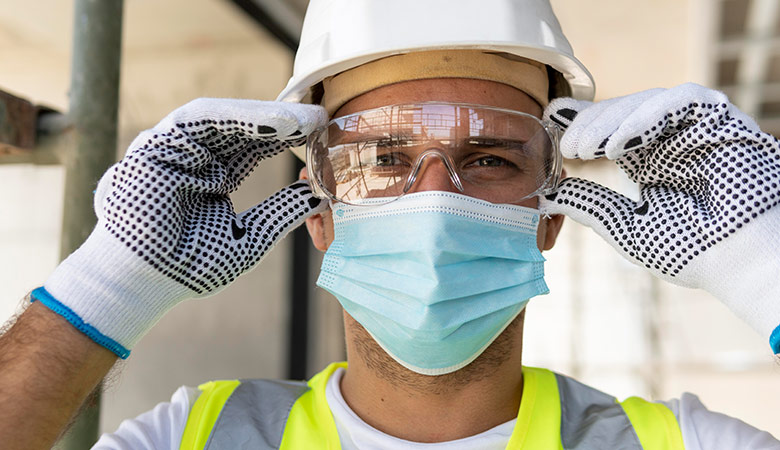Lavagem Industrial / Artigos
Occupational Health and Safety: more relevant than ever?
In an organization, dangers lurk around every corner, even if you can’t see them. This is how Occupational Health and Safety can prevent accidents and make companies stronger.

 9 minutos de leitura
9 minutos de leitura
2022-11-10 16:44:40
In an organization, dangers lurk around every corner, even if you can’t see them. This is how Occupational Health and Safety can prevent accidents and make companies stronger.
Seven stadiums, a new airport, an entire subway system, several roads and about 100 shiny hotels. The small (and wealthy) Qatar did not mind any expense in preparing for the most expensive World Cup ever. But while most look forward to the opening match,the shocking numbers of work-related accidents overshadow what should be a joyous celebration. So far, there have been 6,500 deaths among workers, mostly foreigners with little state protection and even fewer rights.
The situation in Qatar has received deserved media attention and international condemnation. But far from the spotlight, accidents and occupational diseases around the world cause as many victims as Qatar has faced in the past 10 years – every day. According to theInternational Labour Organization, there are nearly 1 million daily workplace accidents, resulting in the astounding number of 6,000 fatalities directly related to poor working conditions. And this may not be the actual extent of the problem, as many of the accidents (and even deaths) go unreported. The need for sound Occupational Health and Safety standards and best practices is obvious in this context. But what exactly does this concept mean?
What is Occupational Health and Safety?
Occupational Hygiene and Safety is a term that covers legal requirements to prevent accidents, injuries and health problems in workplaces or public environments. Each country has its own legislation which defines the general prevention standards to ensure the well-being of workers.
Occupational Hygiene and Safety standards apply to all branches of activity without exception. Certain areas, such as food orhospitals, have their own detailed rules,covering everything from hygiene plans to pest and water control, as well as raw materials sourcing and waste management.
Why is Occupational Health and Safety important?
Until the 1950s, regulation on Occupational Health and Safety was the exception, not the rule. As a result, death tolls reached record levels, between four-and five-times what countries like the US face today. The overwhelming majority of victims were because of traumatic injuries caused by falls, electrocution and machine accidents. Large companies employed doctors and nurses and had set up on-site clinics to treat traumatic injuries.
Besides the fatalities and workers who found themselves incapacitated by one of these accidents, there were obvious costs for companies. The number of workhours lost, the equipment that had to be repaired or replaced. The expert fees and legal actions, besides lost productivity by the victim–and the high rotation of employees in these environments.
Occupational Health and Safety as we know it is a product of this environment. Over time, its importance became clear. More than a legal and social obligation, it has grown into a fundamental element of a company’s success, with a direct impact on the reputation and trust of customers, as well as on the motivation of workers and, therefore, results.
But despite its importance and the long road already taken, work-related accidents and illnesses still cost around 4% of the world’s GDP. And this is only a small part of the immense suffering caused by the risks in the workplace. About 160 million people suffer from work-related illnesses. The number of fatal and non-fatal accidents at work is estimated at 270 million per year and there are glaring regional differences, with some countries having mortality rates up to four times higher than others. How can companies cope with this problem in a practical way?
How to implement Occupational Health and Safety?
Each company is subject to certain specific obligations depending on their activity. However, there are some general principles that apply to all industries.
1. Assess risks
First, it is important to scan potential environmental and operational risks associated with functions, to eliminate or reduce their effects as much as possible. Hazards that go unidentified cannot be controlled.
Businesses may consult with workers, perform systematic observation of tasks, reevaluate the business layout and test self-protection measures. Individuals with special vulnerabilities, such as pregnant women or people with reduced mobility should also be considered so that the tasks are appropriate for the person performing them, without endangering their physical or psychosocial integrity. For each risk factor, a prevention and intervention strategy should be developed to eliminate or control hazards when possible.
2. Reorganize the workspace to minimize the risk
The workspace must be optimized to ensure safety and comfort while performing tasks. It is important to create separate work areas for activities that cannot be overlapped, a concern which is especially relevant in the food and hospital area.
For example, restaurants should define work areas unique to cleaning, cutting and preparation, and each employee should work in the area assigned to them. Many companies benefit from the organization of the work environment with the 5S method, to obtain a more productive, ergonomic and safe space, with less waste and higher quality. This method is governed by 5 principles: Sorting, Straightening, Shining, Standardization and Sustaining, which, over time, provide a positive transformation.
3. Implement the measures identified
Proactive measures should be taken to ensure hygiene and safety at work based on existing legislative principles. For example, it is essential that food companies and hospitals ensure that there is no transfer of substances between utensils and surfaces, to avoid causingfood poisoning or promote the spread of bacteria and viruses. Industrial washing machines, such as the MultiWasher, ensure the perfect hygiene of utensils, with a minimum expense of water, detergent and energy.
It is also important to provide safety equipment to employees and ensure that they observe their correct and permanent use. Some items, such as goggles or technical gloves, can make a difference and must be ergonomic enough not to discourage workers from using it.
4. Monitor results
After implementing the necessary Occupational Health and Safety measures, it is important to make a permanent follow-up to ensure that they are producing the desired effect. For example, food companies should ensure that raw materials are safe for consumption and that they are treated and stored in such a way as to preserve their characteristics and properties.
There are many cases of restaurants suffering significant financial and reputational losses after raw materials were deemed unsafe for consumption. That’s what happened to Bill Miller’s Bar-BQ restaurant chain, which received chicken too salty to be consumed, generating an extraordinarily high number of complaints. Several tons of chicken had to be discarded, racking up to an enormous loss, besides the legal costs of a litigious process.
5. Involve the team
To be truly effective, it is essential to count on the collaboration of workers. Companies should involve and train the team so that everyone is informed about hygiene and safety practices at work.
Employees should have no doubts on how to perform their duties safely, and how to operate the equipment correctly. Raising awareness of the importance of adopting these procedures is an important step towards maintaining the safety and healthiness of the work environment.
MultiWasher, making Occupational Health and Safety a priority
Making Occupational Health and Safety a priority avoids accidents and guarantees companies more expressive results, adhering to the strictest standards of hygiene, efficiency and ergonomics. MultiWasher, developed by Somengil, is a high-tech washing equipment, developed by specialized engineers to reach a perfect hygiene, with maximum efficiency. See for yourself how this state-of-the-art machine will improve your washing processes, and schedule a webinar to see it in action without compromise.
Também pode gostar

Lavagem Industrial / ArtigosArtigos
Food sustainability: what it is and why it matters
More than a buzzword, food sustainability is a global emergency. This is what it means, why it is important and how companies can take action
Postado em 2022-04-28

Lavagem Industrial / ArtigosArtigos
MultiWasher featured in Bloomberg
Bloomberg has highlighted MultiWasher and Somengil as benchmarks in sustainability and efficiency. Find out why.
Postado em 2024-01-02

Lavagem Industrial / ArtigosArtigos
Multiwasher: Revolutionizing sanitation in the food industry
The Multiwasher is the world’s most innovative industrial washing machine that is increasing sanitation across many industries.
Postado em 2023-05-03






















 Português
Português English (UK)
English (UK) English (USA)
English (USA) Français
Français Español
Español Deutsch
Deutsch